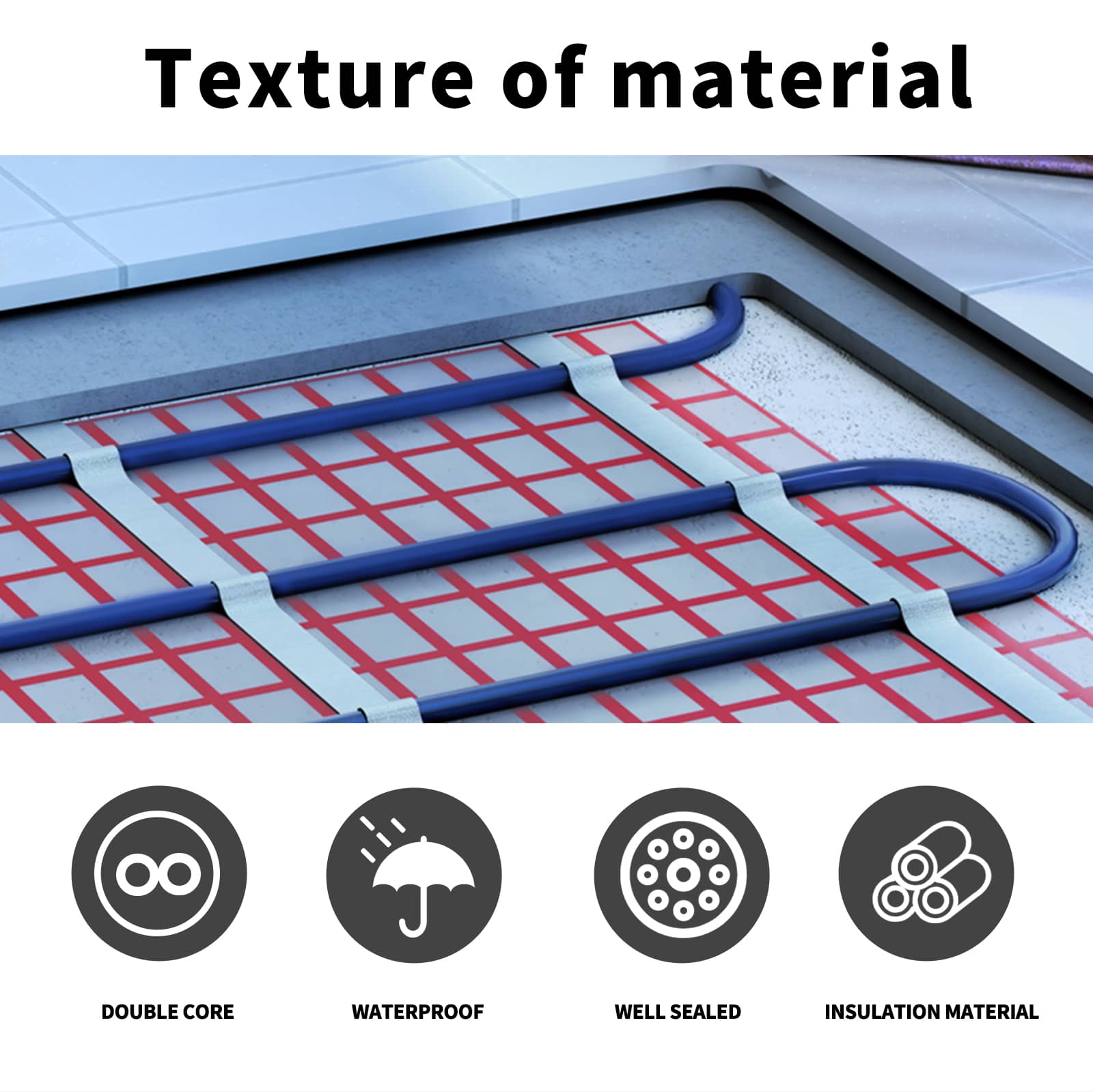Was sind mögliche Gründe für die Nichteinhaltung der Temperaturgleichmäßigkeit in Heizkabeln?
Nov 01, 2025
Die Temperaturverteilung des Heizkabels entspricht nicht den Normen. Die Hauptursachen lassen sich in drei Kategorien einteilen: Abweichungen im Verlegeprozess, Hindernisse beim Wärmetransport und Umwelteinflüsse. Spezifische Untersuchungen können anhand der folgenden Aspekte durchgeführt werden.
1. Abweichungen im Verlegeprozess: Ungleichmäßige Abstände oder unsachgemäße Befestigung führen zu einer ungleichmäßigen Wärmeverteilung.
Dies ist der häufigste Grund, da Heizkabel Die Anordnung während der Bauphase entspricht nicht den Vorschriften, was direkt zu Unterschieden in der lokalen Heizdichte führt.
1.Die Kabelabstände sind stark ungleichmäßig.
- Phänomen: In einigen Gebieten gibt es eine hohe Kabeldichte, in anderen Gebieten hingegen eine zu geringe. Dies führt zu einer Wärmeansammlung in den dichten Bereichen und zu einer unzureichenden Wärmeversorgung in den dünnen Bereichen, was wiederum Temperaturunterschiede zur Folge hat.
- Typisches Szenario: Bei der Erdheizung ist es schwierig, Kabel in Ecken oder um Rohrleitungen herum zu verlegen, was zu Kabelbündelungen führen kann; Bei der Rohrleitungsisolierung schwankt der Abstand der Spiralwicklungen zwischen Breiten und Verengungen.
2.Durch das Biegen oder Überlappen von Kabeln entsteht lokale Überhitzung.
- Phänomen: Der Biegeradius des Kabels ist zu klein oder es kommt zu Überlappungen, wodurch die Wärmeabfuhr im Biege-/Überlappungsbereich behindert wird und eine Temperatur entsteht, die mehr als 5 °C höher ist als im Normalbereich.
- Risikopunkt: Im Überlappungsbereich herrscht nicht nur ein großer Temperaturunterschied, sondern es kann aufgrund der langfristig hohen Temperatur auch zu einer beschleunigten Alterung der Isolierschicht kommen.
3.Eine lockere Befestigung führt zu einer Kabelverschiebung.
- Phänomen: Nach der Fertigstellung werden keine speziellen Klemmen (z. B. Edelstahlklemmen) zur Befestigung der Kabel verwendet, oder der Abstand zwischen den Befestigungspunkten ist zu groß (z. B. horizontale Verlegung > 50 cm), wodurch die Kabel durch ihr Eigengewicht durchhängen oder sich verschieben und der ursprünglich gleichmäßige Abstand gestört wird (z. B. rutschen die Kabel bei der Bodenerwärmung zur Seite).
2. Wärmeleitbarrieren: Isolierung/Versagen der Isolierschicht oder ungleichmäßiger Wärmewiderstand
Die Wärme kann nicht gleichmäßig auf das zu behandelnde Objekt (Boden, Rohrleitung) übertragen werden, und selbst wenn das Kabel gleichmäßig verlegt wird, können aufgrund von Problemen im Wärmeübertragungsprozess Temperaturunterschiede auftreten.
1.Beschädigte Isolierschicht, lose Verbindungen oder ungleichmäßige Dicke
- Szenario der Bodenerwärmung: Die Dämmschicht (z. B. extrudierte Polystyrolplatten) weist Risse auf, die Fugen sind nicht mit Klebeband abgedichtet oder die Dicke ist stellenweise unzureichend (z. B. 20 mm in der Planung, nur 10 mm in der Realität), Wärme geht aus den beschädigten/dünnen Bereichen verloren, und die entsprechende Temperatur in dem Bereich ist niedrig (z. B. Leckage in der Dämmschicht der Wandecke, wobei die Temperatur in der Ecke 4 °C niedriger ist als in der Mitte).
- Szenario bei der Rohrleitungsisolierung: Die Isolierwolle (z. B. Steinwolle) ist nicht fest um die Rohrleitung gewickelt, oder es gibt Lücken an den Verbindungsstellen, was zu einer zu schnellen lokalen Wärmeableitung durch das Eindringen kalter Luft führt und eine ungleichmäßige Oberflächentemperatur der Rohrleitung zur Folge hat.
2. Baumängel in der Füllschicht (Erdheizung)
- Phänomen: Ungleichmäßige Dicke der Zementmörtel-Füllschicht (z. B. 50 mm im Entwurf, aber nur 30 mm in einigen Bereichen) oder unzureichende Aushärtung (z. B. zu kurze Aushärtungszeit und eingeschaltete Stromversorgung), was zu Rissen in der Füllschicht, schneller Wärmeableitung durch die Risse und niedrigen Temperaturen im entsprechenden Bereich führt.
- Ein weiteres Szenario: Verunreinigungen (wie z. B. zu viele Steine) werden in die Füllschicht eingemischt, was zu einer Verringerung der Wärmeleitfähigkeit und zur Bildung lokaler "Wärmebarrieren" führt, die einen Temperaturanstieg verhindern.
3. Die Oberfläche des kontrollierten Objekts ist uneben.
- Bei der Isolierung von Rohrleitungen können Rost, Vorsprünge oder Vertiefungen an der Oberfläche der Rohrleitung auftreten, und die Heizkabel Eine feste Befestigung (z. B. durch im erhöhten Bereich hängende Kabel) ist nicht möglich. Die Wärmeübertragungseffizienz im hängenden Bereich ist gering, und die Temperatur liegt 3 °C bis 5 °C niedriger als im befestigten Bereich.
3. Umwelteinflüsse: Externe Faktoren, die zu lokalem Wärmeverlust oder Wärmeansammlung führen.
Äußere Umwelteinflüsse wie Temperatur und Luftströmung stören den Wärmehaushalt und verursachen lokale Temperaturunterschiede.
1. In der Nähe von Wärme- oder Kältequellen
- Phänomen: Der Heizbereich befindet sich in der Nähe von Klimaanlagenauslässen, Fenstern (wo im Winter kalte Luft eindringt), Heizkörpern usw., und die Wärme wird an der Kältequelle abgeführt, was zu einer niedrigeren Temperatur führt; In der Nähe anderer Wärmequellen (wie z. B. Küchenherden) ist die lokale Temperatur relativ hoch.
- Typisches Szenario: Bei der Bodenheizung dringt ohne zusätzliche Dämmung unter dem Fenster kalte Luft durch die Fensterspalten ein, wodurch die Temperatur im Bereich unter dem Fenster um 4 ℃ bis 5 ℃ niedriger ist als in der Mitte des Raumes.
2. Luftstrombehinderung
- Phänomen: Im Heizbereich herrscht ein starker Luftstrom (z. B. Abluftventilatoren in Industriehallen oder Deckenventilatoren in Haushalten), der die lokale Wärmeabfuhr beschleunigt und zu niedrigeren Temperaturen im entsprechenden Bereich führt (z. B. ist die Temperatur im dem Ventilator zugewandten Bereich um 3 °C niedriger als im abgewandten Bereich).
3. Einfluss von tragenden oder bedeckenden Materialien
- Phänomen: Die Bodenheizfläche ist teilweise mit schweren Gegenständen (wie großen Möbeln und Teppichen) bedeckt, und die Wärme im bedeckten Bereich kann nicht abgeführt werden, was zu einer höheren Temperatur führt (mehr als 4 ℃ höher als im unbedeckten Bereich); Oder lokale Langzeitkompression (wie z. B. durch häufig begangene Laufwege), Verdichtung der Füllschicht führt zu einer Verringerung der Wärmeleitfähigkeit und niedrigeren Temperatur.

